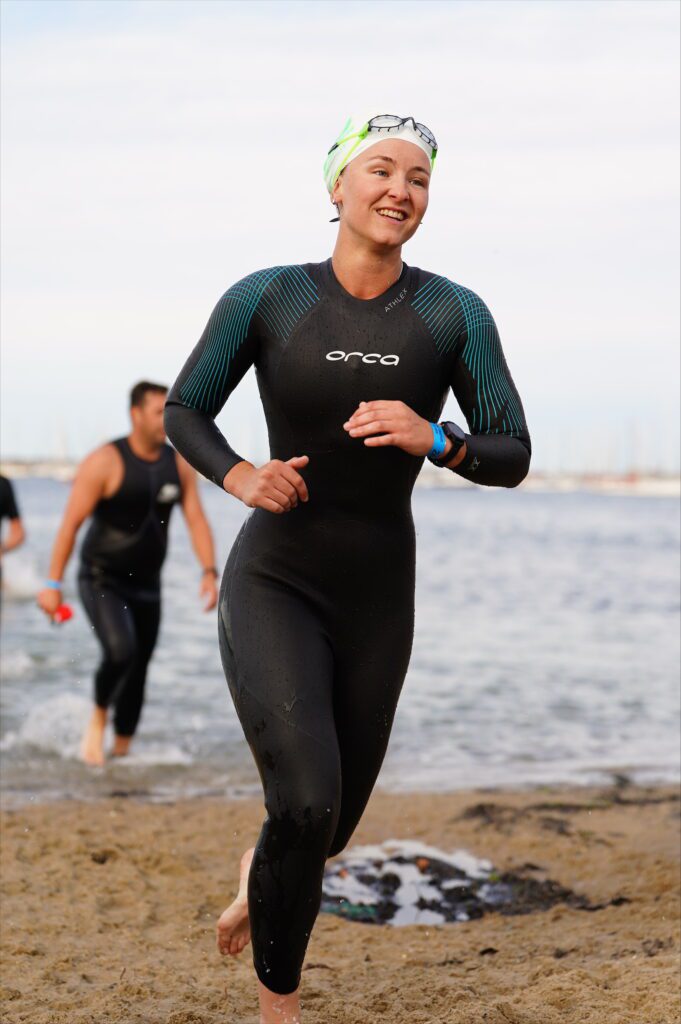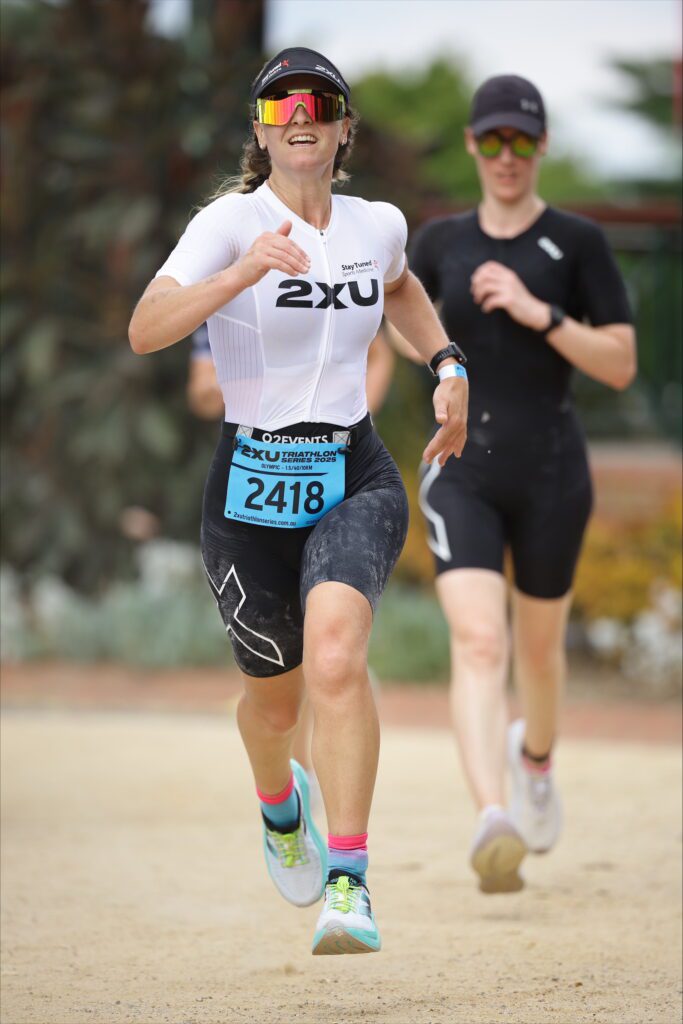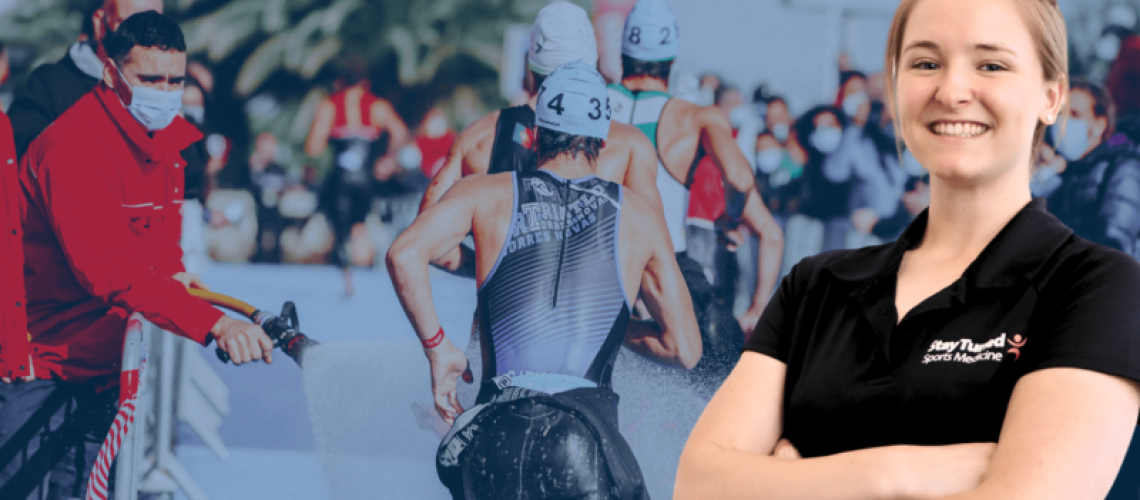A year ago, if someone had told me I’d be training for my first Ironman 70.3, I would have laughed. I strongly disliked running and hadn’t swum since high school. But as a former competitive gymnast, I was ready for a new challenge in endurance sports—and triathlon training quickly became my passion.
As a kinaesthetic learner, I’ve always understood how the body adapts to physical activity. This hands-on experience has helped me support my clients who swim, cycle, or run. After working with enough triathletes, I felt inspired to try the sport myself. I began with my first Sprint Triathlon in March 2024, and since then, I’ve been hooked.
Table of Contents
Why Triathlons Are the Best Endurance Sport for Beginners
There’s something powerful about triathlon training—it strengthens the mind and body while offering a sense of achievement. The sport provides:
- A structured training plan that improves cardiovascular endurance
- A highly supportive community through triathlon clubs and events
- Inclusivity, with options ranging from beginner-friendly Sprint Triathlons to Ironman events
- A low-impact alternative to running-only sports, reducing injury risk
Triathlons cater to all fitness levels, offering distances like Fun Tri, Sprint, Olympic, Ironman, and Para-triathlon events. No matter your starting point, there’s a triathlon for you.

Top Triathlon Injuries & How to Prevent Them
Training for three disciplines in one race places a significant load on the body. Unfortunately, overuse injuries are common. Here’s a breakdown of the most frequent injuries in each sport and how to avoid them.
Swimming Injuries
Swimmer’s Shoulder is caused by rotator cuff tendinopathy or impingement due to overuse, poor form, or muscular imbalances.
Prevention Tips:
- Strengthen shoulder stabilisers (rotator cuff, serratus anterior)
- Improve swimming technique with a coach or swim analysis
- Incorporate rest and recovery to prevent overuse
Cycling Injuries
Patellofemoral Pain Syndrome (Cyclist’s Knee) results from poor foot positioning on pedals, muscular imbalances, or improper bike fit.
Prevention Tips:
- Bike fitting: Ensure proper saddle height and cleat positioning
- Strength training: Focus on quadriceps, glutes, and core stability
- Gradually increase cycling intensity to avoid overuse stress
Lower Back Pain is common in cyclists due to poor posture, weak core muscles, or sacroiliac joint dysfunction.
Prevention Tips:
- Adjust bike posture to minimise spinal stress
- Strengthen core and lower back muscles
- Stretch hip flexors to counteract prolonged sitting
Running Injuries
IT Band Syndrome is pain along the outer knee caused by tightness and friction in the iliotibial band.
Prevention Tips:
- Strengthen hip abductors and glutes
- Avoid excessive downhill running
- Stretch and foam roll the IT band regularly
Platar fasciopathy (heel pain) is often caused by poor footwear, overuse, or tight calf muscles.
Prevention Tips:
- Wear supportive running shoes (consider gait analysis)
- Strengthen foot muscles with toe curls & arch support exercises
- Gradually increase training load to avoid sudden stress

Triathlon Injury Prevention: Best Tips for Swimmers, Cyclists & Runners
1️⃣ Smart Training & Load Management
- Mix up your sessions between swimming, cycling, and running
- Incorporate low- and high-intensity workouts for endurance & recovery
- Use a triathlon training plan or join a triathlon squad for guidance
2️⃣ Strength Training for Triathletes
- Build glute, core, and leg strength to prevent injuries
- Identify weaknesses through running assessments (available at Stay Tuned Sports Medicine)
- Use resistance bands and weights to develop endurance
3️⃣ Proper Footwear & Bike Fit
- Running shoes should be replaced every 500-700 km
- Alternating between two pairs of shoes extends their lifespan
- A professional bike fit can reduce knee and back pain by adjusting seat height and posture
4️⃣ Technique & Professional Assessments
- Swim Lessons: Improve efficiency with stroke analysis
- Bike Fit: Proper alignment prevents chronic pain & overuse injuries
- Running Gait Assessment: Identifies weaknesses & optimises form

Frequently Asked Questions (FAQs)
❓ How do I transition from another sport? Start with Sprint Triathlons and cross-train before focusing on a specific discipline. Gradually build your endurance and technique in swimming, cycling, and running.
❓ What’s the best way to prevent injuries?
- Strength training and proper recovery
- Professional assessments for swimming technique, running gait, and bike fit
- Gradual progression in training to avoid overuse injuries
❓ What are the best triathlon shoes for beginners?
- Running Shoes: Choose a pair based on your gait analysis
- Cycling Shoes: Ensure proper cleat position to prevent knee pain
- Triathlon-Specific Shoes: Quick transitions and barefoot-friendly options
Ready to Improve Your Performance?
Thinking about starting training or dealing with injuries? Our team at Stay Tuned Sports Medicine specialises in running assessments, bike fitting, and injury prevention for triathletes. Book an appointment today to optimise your performance and reduce injury risk.
📍 Visit Stay Tuned Sports Medicine | 📅 Schedule an Assessment Today
References
- Asplund, C. A., & St Pierre, P. (2004). Knee pain and bicycling: Fitting concepts for clinicians. The Physician and Sportsmedicine, 32(4), 23-30.
- Burnett, A., Cornelius, M., Dankaerts, W., & O’Sullivan, P. (2004). Spinal kinematics and trunk muscle activity in cyclists: A comparison between healthy controls and non-specific chronic low back pain subjects. Manual Therapy, 9(4), 211-219.
- Cook, J. L., Rio, E., Purdam, C. R., & Docking, S. I. (2016). Revisiting the continuum model of tendon pathology: What is its merit in clinical practice and research? British Journal of Sports Medicine, 50(19), 1187-1191.
- Friel, J. (2016). The Triathlete’s Training Bible. Boulder, CO: VeloPress.
- Gibson, J., Baker, M. J., & Pendleton, H. (2021). Social influences on triathlon participation: The role of the triathlon community. Journal of Sports Science & Medicine, 20(1), 34-45.
- Hannigan, J. J., & Pollard, C. D. (2020). Differences in running biomechanics between a traditional and a maximalist shoe. Journal of Science and Medicine in Sport, 23(3), 254-259.
- Joyce, D., & Lewin, G. (2014). High-performance training for sports. Human Kinetics.
- Noehren, B., Davis, I., & Hamill, J. (2007). ASB Clinical Biomechanics Award Winner 2006: Prospective study of the biomechanical factors associated with iliotibial band syndrome. Clinical Biomechanics, 22(9), 951-956.
- Reiman, M. P., & Loudon, J. K. (2018). Assessment and Treatment of Muscle Imbalance: The Janda Approach. Human Kinetics.
- Taylor, J. (2019). The Psychology of Triathlon. Routledge.
- Tenforde, A. S., Borgstrom, H., & Chang, A. (2017). Overuse injuries in triathletes: A review of the literature. Sports Health, 9(2), 151-159.
- Willy, R. W., & Meardon, S. A. (2018). Running biomechanics and the effects of gait retraining on injury risk. Sports Health, 10(1), 30-37.
- Yates, B., & White, S. (2004). The incidence and risk factors in the development of medial tibial stress syndrome among naval recruits. American Journal of Sports Medicine, 32(3), 772-780.

